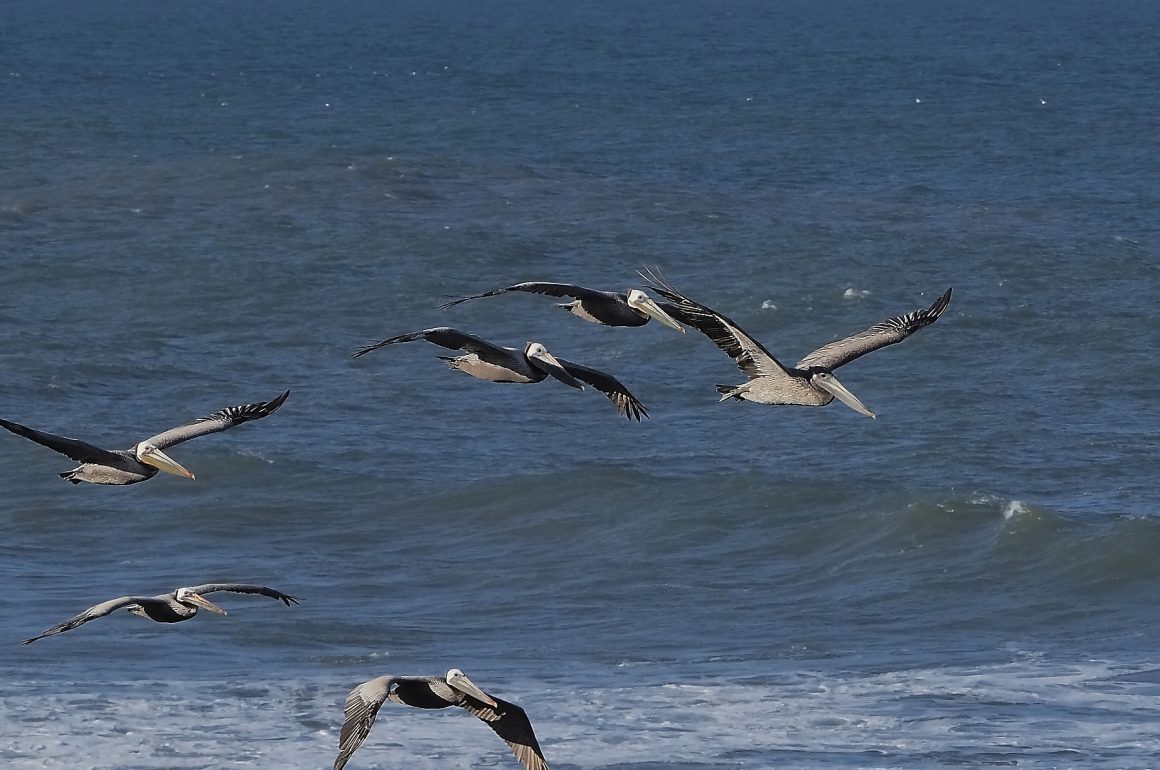
Back when I was a kid growing up in California’s San Mateo County in the 60s and 70s, my family would occasionally drive 45 minutes west and south to Bean Hollow State Beach. Even now, I remember my mother commenting how that goofy English name sounded so much more romantic in its original language: Arroyo de los Frijoles. Little did I imagine that someday I would live much of my life in that same Spanish language.
There are many beautiful beaches along the San Mateo County coast. What makes Bean Hollow stand out is that along with a rather pebbly beach, it also has some wonderful tide pools full of very accessible marine life. As for birds, well, I wasn’t paying much attention back then. Still, I have very fond memories of the times we spent there.
Moving to the present, while I was on the Sequoia Audubon Club trip I described last week, I mentioned to one of the organizers that I was hoping to see some ocean birds passing by the coast, as those would give me my best chance at lifers for this region. She, very kindly, immediately started figuring out how she could make this happen. And the day after the outing, she sent me a very interesting list for a recent day on the coast, along with the e-mail for the observer, one Peter Metropulos.
I had planned on turning up for a short fieldtrip with SAS on one of the less interesting beaches on Sunday, starting at 10 a.m. But no one would miss me at our temporary home here, if I left earlier than the required 9 a.m. So, without too much optimism, I wrote Peter a message to see if by any chance he would be doing a seabird watch that morning. And, to my surprise, he quickly wrote back to invite me to accompany him on an already planned outing that morning. Where? Why, Bean Hollow, of course. I was happy to tell him I knew exactly where it was.
I have never had the privilege of going on a pelagic trip (an ocean boat trip for the purposes of seeing seafaring birds). And in Mexico, we live a four-hour drive from the ocean. So I knew nothing about watching seabirds from the shore, either. But after just two and a half hours with Peter, I know much, much more about this art.
Peter says that he doesn’t care much for guiding groups. But he was certainly patient with me. He pointed out the differences in the day’s five gull species, all of which flew fairly close to the bluff from which we watched. I now know that Western Gulls are large and have very dark wings with large white “mirrors” on their black wingtips. California Gulls are also large, but have somewhat lighter wings with barely noticeable mirrors. The much rarer Glaucous-winged Gulls (lifer!) look very washed out, or “ghostly”, as Peter said. The dozens of Bonaparte’s Gulls (lifer!) that flew by on their way north were much smaller, many with black heads, and flew much like terns or swallows. And to my surprise, the one gull of the day that I already knew well was perhaps the day’s biggest rarety, as a Franklin’s Gull had never been reported at this site. Fortunately, I managed a decent photo to prove its passage:
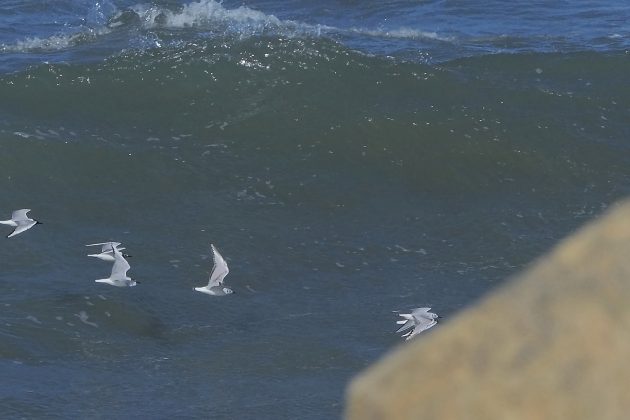
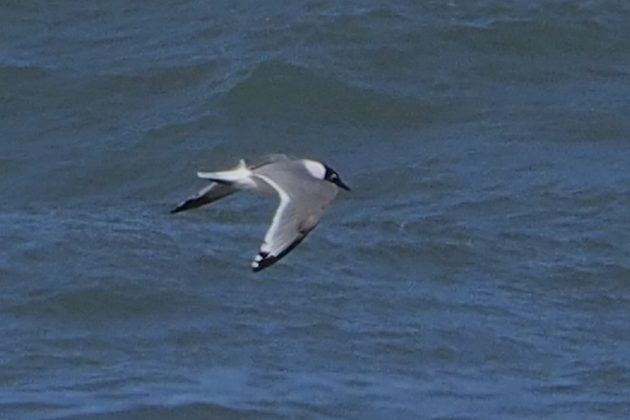
Peter told me that he doesn’t bother with identifying immature gulls. I like this guy.
A bit farther offshore, coastal California’s three cormorants all made an appearance: Many Brandt’s, a handful of Pelagics, and two Double-crested Cormorants, more often found inland. The first are dark with only a lighter chin, the second have a noticeably white patches below their rump, and the latter have much orange on and around their bills. Of course, I had known none of this when the day began.
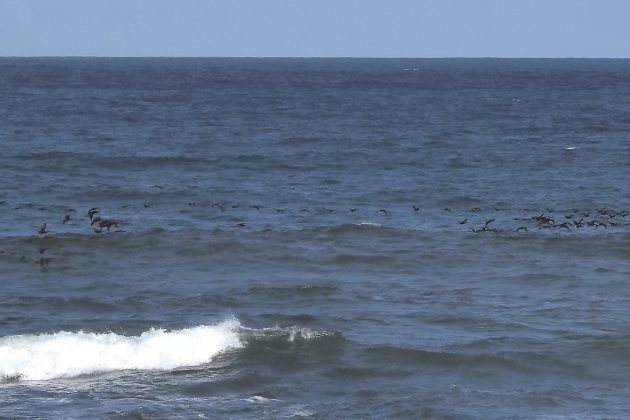
The same goes for the three species of loons flying by. The many Pacific Loons (lifer!) flying north would be gray above, with a contrasting black patch on the throat. The few Red-throated Loons (lifer!) lack that dark throat patch, and might even show a light patch there at this time of year. Common Loons, which weren’t at all common, distinguished themselves with a wonderfully clear black-and-white pattern, including a black, black head and neck ring. Frankly, I leaned a lot on Peter for the ID of the first two species. You can see in this photo that the Pacific Loons wer well beyond optimal photographic distance.
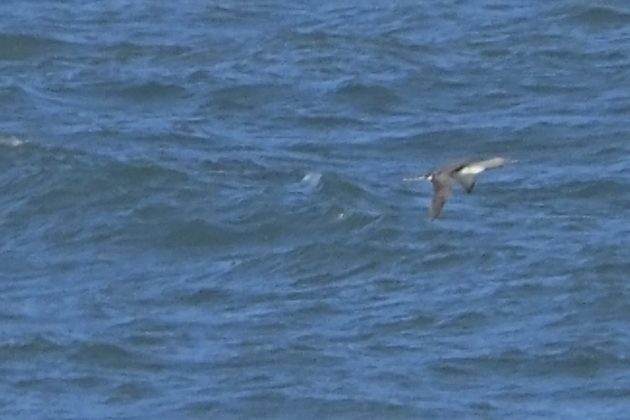
And then, too far out for any possibility of photography, came the really good stuff: Peter quickly told me that the two-toned footballs out there were Common Murres. Lifer!, and my first member of the auk/puffin family. It took me a while to move beyond the “I think I see it… Maybe…” stage. But eventually I had seen enough Murres to detect a couple that looked only about half-sized. Peter shouted “Oh, good! I had hoped you would get to see Marbled Murrelets!” (Lifer!) These fascinating little birds turn out to spend most of their lives acting like typical seabirds, but they nest in the crowns of old-growth trees in Pacific Northwest forests.
And finally, I also managed to locate the black birds with white wing patches he kept pointing out. These were Pigeon Guillemots, a classic auk. I truly wish I could show photos of these last three species, but geez, they were far from shore.
The day was rounded out by many, many Brown Pelicans, two Black Oystercatchers (lifer!), several Surf Scoters (aka Surfing Ducks), and a Purple Finch I was finally able to distinguish from California’s ubiquitous House Finches (lifer!, because it sang). Add those to one very wild California Sea Lion, and I had quite the morning. Many thanks to my fantastic host, Peter.
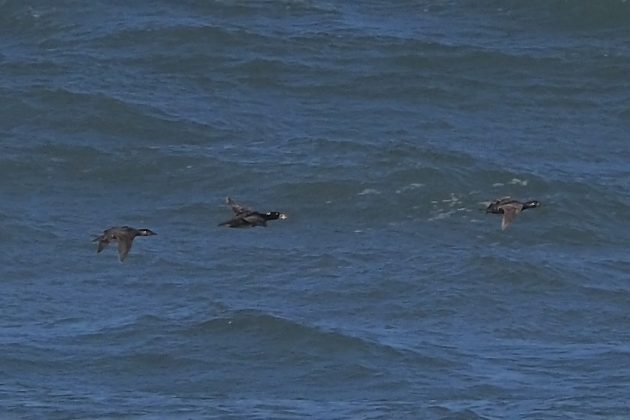






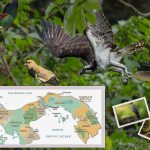
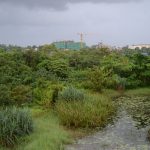

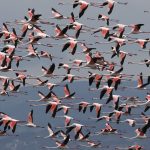



Did you use a telescope, Paul? I find seawatching very challenging without one.
Peter had one, which he used with great ability. Me, not so much.
Nice trip. I too grew up on the Peninsula and I spent a great deal of time on the San Mateo coast before moving north to Portland. My best Bean Hollow day was back when a beached whale got chewed up by the rocks over a period of days, causing many birds to come to that feast. That included North Fulmars literally on the beach.
https://youtu.be/KKbH59iJVdA?si=k5-jQYm76mW2tbMc
https://ebird.org/checklist/S7155032
One last note, since I doubt I can make a blog out of this: I took my wife back to Bean Hollow Beach a few days later, and thought I saw the Sea Lion again. But when I looked at this one, its head seemed to be held backwards. It was a California Sea Otter! Their official northern range limit, according to Wikipedia, is currently at Año Nuevo State Park — about 12 miles south of Bean Hollow. So it was very exciting to actually witness the continual recovery of this once almost-extinct species. Plus, they are adorable!